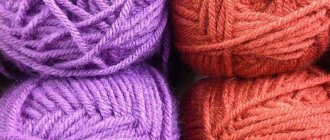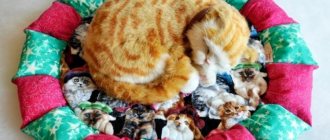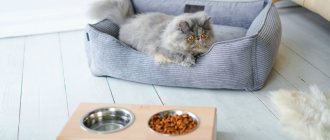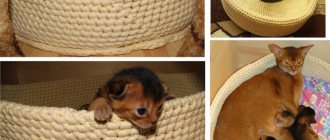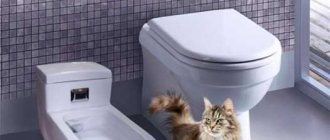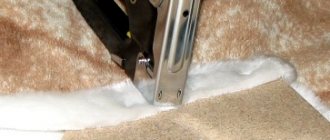Many people think that pet clothing is only for dogs. This is fundamentally not true, because lately more and more things have been appearing for cats and other pets. Most of the clothes are intended for walking short-haired cats and Sphynx cats. They freeze faster than others and need warmth. One of the necessary types of clothing for cats is a blanket after sterilization. This material will tell you how to sew a blanket for a cat after sterilization - the pattern and the sewing process itself.
Features of sewing clothes for cats
One of the features of sewing clothes for cats is the choice of materials. Everything here is very individual, since this particular fabric and this particular style will suit each individual cat. And it’s not just about the breed, but also about the coloring of the pet’s coat, the size of the pet, and even the place it occupies in the owner’s heart.
Cat apron
In any case, special attention should be paid to natural materials. It is also possible to use fabrics with a small amount of synthetic fibers. The best option would be: cotton fabrics, linen, wool, viscose. They are pleasant not only for humans, but also for cats. You should also look at the characteristics of the material: how well it is made, whether it fades in the sun, or whether it deforms after washing.
Bow and dress
Also among the features is taking measurements of cats, which, naturally, differ from dogs, and even more so from humans. Taking measurements from animals is not so easy, since they constantly strive to break free.
McDonald's apron version
Product functions
The need for the cat to wear a special blanket or bandage during the postoperative period is determined by the doctor who performed the operation. Sometimes the specialist is able to place stitches in such a way that the cat does not need additional support. Therefore, wearing a bandage is not prescribed.
In most cases, the presence of a blanket is necessary, since additional protection of the operated area from dirt and pathogens is required. Contact of any contaminants or pathogens on unhealed wounds can cause an inflammatory process, which can lead to various complications. The blanket will close the seams from the external environment, thereby promoting faster healing of wounds.
This bandage prevents the pet from licking the operated area. The tongue of these furry animals is very rough. Therefore, he is able to damage the stitches, opening the wound. Cat saliva is considered a natural antiseptic. But it contains a large number of bacteria, some of which can cause inflammation. The blanket is an excellent protection against these two risk factors.
Wearing also limits the animal's mobility, thereby minimizing the possibility of seams coming apart due to the cat's activity. During the postoperative period, ichor or blood may leak from a still fresh suture. Such discharge not only stains your pet's fur, but can also remain on furniture or clothing. In the summer, such secretions attract blood-sucking insects that can carry pathogens. Wearing a special bandage helps prevent contamination of fur and objects, as well as protect wounds from contact with insects.
A homemade or purchased blanket is excellent protection for sutures, and also makes caring for a pet who has undergone surgery much easier. Only in rare cases, when a doctor uses a special suturing technique, will wearing a bandage be undesirable.
Something else interesting: Basic rules and nuances of keeping sphinxes
How to take measurements from a cat
The main measurements to take are:
- neck girth. This is the circumference of the neck at its thickest and widest point. This is usually its base. To ensure an even measurement, it is necessary to place the animal on a flat surface;
- back length. The measurement is taken from the base of the neck to the beginning (root) of the ponytail. A centimeter placed along the spine is best suited for this;
- sternum girth. This measurement is taken around the widest part of the chest - under the front legs.
You might be interested in this How to choose a needle for a sewing machine yourself
These measurements are enough for most products, but sometimes additional data is needed. For example, the distance between the paws.
Cat measurements
How to sew a post-operative blanket for a cat after sterilization
Blankets after sterilization are not always available for sale in veterinary pharmacies and other pet stores. If there is an urgent need for a post-operative bandage for a cat, then you can make it yourself. By looking at any pattern, you can make sure that there is nothing complicated in such a product, since it is a continuous piece of fabric with recesses for the paws and ropes for fixing it on the cat’s body.
DIY cat clothes without a pattern
Before making a blanket, you need to know the dimensions of the cat, which will be reflected in the diagram. Next, a pattern is made, on the basis of which a single piece is made from cotton fabric or flannel.
Important! It is recommended to use a light-colored fabric that immediately shows all dirt. This will help you consult a doctor in time if bleeding occurs due to a sudden divergence of the stitches.
Homemade blanket after sterilization surgery
Choosing fabric for blankets
The fabric must meet the following requirements:
- be soft and elastic, but not stretch too much;
- do not crumble or fall off in pellets, so as not to contaminate the wound, around which it is necessary to maintain sterility;
- be plain and preferably unpainted, so that dirt can be more easily seen.
Scheme of the blanket and options for its fastening
Velcro or ribbons - which is better?
The pros and cons of fasteners can be included in a separate section, since the process of their manufacture is always one of the most important. For some animals, Velcro is more suitable, and for others, ribbons are more suitable. This is based on the advantages and disadvantages of any type of fastening. Among the positive aspects of ribbons are:
- the ability to be made from the same fabric as the main part;
- ease of sewing;
- impossibility for the animal to untie them on its own.
An option for making a medium-sized blanket
. There are also disadvantages:
- the animal will cling to some objects in the room with them and play when the length is too long;
- you can overtighten the animal;
- Difficulty in untying if the knot is too tight.
Homemade blanket
Velcro also has its advantages and disadvantages. Among the advantages:
- ease of fixation;
- they are more compact compared to ribbons.
Flaws:
- their cost is higher;
- they quickly become dirty with wool;
- Easy to unfasten even for the most clumsy animal.
Blanket after surgery
Dressing rules
Place the blanket on the pet, having first laid it on its side. Then they bring its edges together and tie the ribbons. The product should not be fixed too tightly. A properly worn bandage should fit snugly to the body and not sag or dangle. Strongly tightened ropes impair blood circulation at the dressing site, which increases the healing time of tissues. For greater reliability, the ribbons are secured to the paws and neck; their edges should be short.
They remove the blanket in the same way as they put it on. The cat is placed on its side, the fastenings are untied and the product is removed. Every day you need to allow the animal to walk for at least half an hour without a bandage, this will allow the seam to dry out faster. They finally get rid of the dressing material only on the day when the veterinarian allows it. This usually happens 8-9 days after surgery.
All owners of sterilized cats are faced with the fact that their pets take off their blankets. It will not be possible to constantly monitor the animal, so they resort to more stringent measures. At night, you can limit your cat's movements by placing her in a cramped crate or portable basket. She will not have the opportunity to run and twirl, so the blanket will remain in place.
Additionally, a surgical collar is put on the animal . Thanks to him, the cat will not be able to pull off the bandage with its teeth. If there is increased activity, the veterinarian may prescribe sedatives. They calm the pet and do not allow it to actively move.
But still, the main responsibility for the condition of the cat after sterilization lies with the owner. He needs to constantly stroke the animal and talk to it. This way, your pet will quickly get used to the blanket and stop trying to remove it.
Sewing blankets from improvised materials
Below we will describe how and from what you can make a blanket if you don’t have any suitable material or patterns at hand. You don't need any special cutting and sewing skills.
You might be interested in: Features of cutting and sewing a pencil skirt
Scheme of overalls for a cat
Pantyhose blanket
The simplest option, which requires virtually no resources. There is only one rule: you need to use clean tights, since the animal definitely needs sterility after surgery and sterilization. It is recommended to use thick tights that will fit the cat's body well.
Important! The blanket is made like this: a piece of trouser leg 20 cm long is cut off and pulled over the cat’s belly. Additionally, you can make holes for the paws.
New Year's suit for the British
Sock blankets without ties
The product is made from socks or stockings in the same way. Find the perfect size sock and cut off the front to create a fabric tube. The cat's body is inserted into it, fixing its stomach.
For your information! The most remarkable thing is that even if you don’t have the appropriate sizes at home, you can always buy clean and new socks at any clothing store for a few tens of rubles.
Cat blanket from a baby bodysuit
Blanket from old children's clothes
Old children's clothing in the form of jumpsuits and vests also works well. You should choose something that fits comfortably on your body and is fixed on it. If you don’t have anything like this at hand, then you can make a blanket from an ordinary sleeve of a children’s jacket that stretches well.
Fashionable outfit with a hood
Towel blankets
The most common option involves making it from a simple cotton towel. A cut of the required length is made, and holes for the paws are cut out, based on the anatomical features of the cat. Holes are cut in it for the neck, paws and sometimes the tail. The final stage involves creating a cylinder by sewing the ends of the towel together or sewing on strings.
If the cat is to be sterilized, then you need to buy a blanket
Bandage pattern
After the measurements are taken, they need to be transferred to paper.
After transferring all the measurements to the pattern, you need to add 2 cm of allowance for stitching the edge of the bandage.
The blanket can be sewn in a single layer, but it is best to make three layers of fabric. Since the wound often oozes ichor, one layer will quickly become saturated and wet. This state of affairs is harmful. Firstly, for a wound, it absolutely does not need to be in a humid environment. Secondly, cats do not lie in one place and the pet will stain the furniture, bed and carpets with liquid oozing from the wound.
The fabric for sewing must be chosen with sufficient density so that the cat's claws do not tear through it. And at the same time, the fabric must be breathable, otherwise the wound will fester.
Pattern options
The most common option is when the fabric is cut to cat sizes with holes for paws. Sometimes the bandage is cut out in the shape of a triangle, with a hole for the tail. In this case, the longer sides of the triangle cover the body along the paws. The ends of the triangle are wrapped around the cat's midsection and tied in a knot at the back.
Rice. 1. The most common bandage for cats.
Another option is when the bandage is made with passages for the front paws, and the rest of the part is attached with Velcro along the body.
Another type of pattern is done like this. Holes are cut for the head and legs. The upper part is connected with clasps.
What else can you make for your pet?
In addition to blankets, decorative and warming things are often sewn for cats: tuxedos, skirts, light clothes for summer and thick ones for winter. Each requires the use of certain materials and entry-level sewing skills.
Cat skirt
The tuxedo
A stylish accessory that will highlight the elegance of a slender and long cat. This jacket is made according to a simple pattern, but it looks very beautiful, and most importantly, it does not hinder the movement of the animal. For production you will need:
- white fabric (old shirt);
- black fabric (any cut);
- some red cloth;
- Velcro for fixation;
- tailor's tools in the form of scissors, chalk, sewing machine or hand sewing accessories.
Costume for a British kitten
Airy skirt
If a tuxedo is more suitable for keeping warm, then a skirt is more suitable for going out. Usually these outfits are made for show animals, which appear before spectators and judges in original outfits. Skirts as clothing have become increasingly popular lately. The most important thing is that for manufacturing you will need a few materials and ordinary tools:
- a piece of tulle;
- satin ribbon;
- scissors, needle and thread.
You might be interested in: Patterns and sewing of blouses, tops and dresses with peplum
Important! This set is quite enough to make a beautiful skirt for a cat like a tutu without diagrams or patterns.
Pattern of a dress for a cat
Emergency heating
It happens that clothes for a pet are needed extremely urgently and there is not enough time to create patterns, transfer them to fabric and sewing. To quickly warm up, you can use a regular sock. For production you will need:
- one warm sock;
- scissors;
- chalk.
The idea is to make a vest out of a sock. It is very similar to a blanket, but does not require sterility. A tube is made from a sock with holes for the paws. After which it is put on the cat.
Warm sock
Summer minimalism
For the warm season there is no need for warm clothes, so things for summer are aimed at decorating the cat in a certain style. Such accessories can include ties, bow ties, hats and many others. So, to sew a bow tie you will need:
- collar;
- needle, thread and scissors;
- fabric for the butterfly.
Who needs extra warmth?
Representatives of the cat family have long been the owners of fluffy fur coats, which, in addition to external beauty, perform a number of important functions. They warm the mustachioed purrs, protect them from wind, moisture, and also help camouflage domestic predators.
But not all tailed animals are endowed with thick fur. There are completely hairless or very short-haired breeds that are somewhat popular among people prone to allergies. However, such pets require special care. The fact is that their body temperature is always elevated, and in the cold season such cats need additional warmth, which is why their owners dress them up in original things.
Below is a list of cats that need extra warmth:
- The Sphynx is the most famous breed of hairless cat. Famous for its abundance of folds and wrinkles, as well as its large ears.
- Peterbald - the breed appeared thanks to crossing. The coat usually does not exceed 2 mm; some individuals have eyebrows and whiskers.
- Kohana - those with smooth skin, even if they want, will not be able to acquire hair, because they do not have hair follicles.
- Levkoy is another result of crossing breeds. They have funny forward-curved ears and an incredibly easy-going disposition.
- Bambino is similar in appearance to a dachshund due to its long body and short legs, which sometimes makes it difficult for him to jump to the desired place.
- The Elf is a new breed, bred in 2007. A characteristic feature is the ears curved in the opposite direction, which is why they resemble fairy-tale creatures.
- Minskin is a short-legged representative of hairless cats. Unlike other brothers, it has thick hair on its ears and head.
Dress for the sphinx
Using a simple pattern, you can make a beautiful dress for your hairless Sphynx cat. The most remarkable thing is that a dress of this kind can be made from just two pieces. First of all, the main part is made, and then the sundress, which is sewn to the base.
For your information! All this takes very little time, but looks very attractive. Do-it-yourself clothes for the sphinx, the patterns of which are presented in the picture below, can be made in a matter of hours.
Knitted suit on a Canadian cat
Why is this necessary?
Those cat owners who are faced with the issue of sterilizing their cats for the first time may find that making a blanket on their own will be very difficult. However, in any case, after the procedure, you need to check with the doctor whether the animal needs this kind of protection or not.
In some cases, after sterilization of cats, the stitch is placed in such a way that the bandage is not only unnecessary, but can also be harmful. In other cases, the blanket serves as a means of protecting the postoperative suture from such things as:
- microbes;
- fungi;
- dirt.
All this can cause inflammation of the suture, and this is very dangerous for the cat’s health.
The blanket for cats is made of fabric. It is worn after surgery and blocks access to the sutures and promotes rapid wound healing. You can buy a blanket in a specialized store, where there is a large assortment of similar devices. However, in terms of cutting, this product is not at all complicated, and you can sew it yourself, which will help you save a little.
How to train a cat to wear clothes
Extra attributes are unusual for animals, even if they perform quite useful functions. If a cat rejects clothes, then at first you will have to do everything to get the pet used to it. There is one rule: it is necessary to accustom the animal to clothes from a very early age. This very quickly becomes a habit, and the outfit no longer causes rejection.
Important! If the cat is already an adult, then there is no need to be upset. It is worth putting things on it for just a couple of minutes a day, and then gradually increasing the time you spend in clothes. This will teach her not to be afraid of accessories.
DIY pattern and measurements for a Sphynx cat
Thus, patterning clothes for a cat is a simple process that does not require deep knowledge of sewing or the ability to handle highly specialized tools. Warm or decorative clothing for a pet can be made in a couple of hours, following precise step-by-step instructions.
Terms of use
The animal's sutures must be periodically washed and treated during the postoperative period. In the process of performing such actions, the blanket does not need to be completely removed. Only the bottom pair of ribbons is untied. The product must adhere firmly to the cat.
If the bandage is dirty or has strong discharge, it is removed and replaced with a new one. Blankets should be changed regularly to minimize the risk of rotting and wound infection.
The product is completely removed only at the discretion of the veterinarian. If the blanket was made correctly and used correctly, it will ensure a quick recovery for the cat.
